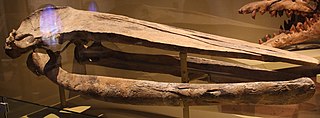The Miocene is the first geological epoch of the Neogene Period and extends from about 23.03 to 5.333 million years ago (Ma). The Miocene was named by Scottish geologist Charles Lyell; the name comes from the Greek words μείων and καινός and means "less recent" because it has 18% fewer modern marine invertebrates than the Pliocene has. The Miocene is preceded by the Oligocene and is followed by the Pliocene.

A pika is a small, mountain-dwelling mammal native to Asia and North America. With short limbs, a very round body, an even coat of fur, and no external tail, they resemble their close relative, the rabbit, but with short, rounded ears. The large-eared pika of the Himalayas and nearby mountains lives at elevations of more than 6,000 m (20,000 ft).

Loons or divers are a group of aquatic birds found in much of North America and northern Eurasia. All living species of loons are members of the genus Gavia, family Gaviidae and order Gaviiformes.

The Cryptobranchidae are a family of fully aquatic salamanders commonly known as the giant salamanders. They include the largest living amphibians. The family is native to China, Japan, and the eastern United States. They constitute one of two living families—the other being the Asiatic salamanders belonging to the family Hynobiidae—within the Cryptobranchoidea, one of two main divisions of living salamanders.

Cetotherium is an extinct genus of baleen whales from the family Cetotheriidae.

Connaraceae is a pan-tropical plant family of 19 genera and more than 180 species of largely evergreen trees, woody shrubs and climbers.

Atherina is a genus of fish of silverside family Atherinidae, found in the temperate and tropic zones. Up to 15 cm long, they are widespread in the Mediterranean, Black Sea, Sea of Azov in lagoons and estuaries. It comes to the low stream of the Dnieper, Southern Bug, Dniester and Danube Rivers.
Paracamelus is an extinct genus of camel in the family Camelidae. It originated in North America and crossed the Beringian land bridge into Eurasia during the Late Miocene, approximately 7.5–6.5 million years ago (Ma). It is the presumed ancestor to living camels of the genus Camelus.

Cetotheriidae is a family of baleen whales. The family is known to have existed from the Late Oligocene to the Early Pleistocene before going extinct. Although some phylogenetic studies conducted by Fordyce & Marx 2013 recovered the living pygmy right whale as a member of Cetotheriidae, making the pygmy right whale the only living cetotheriid, other authors either dispute this placement or recover Neobalaenidae as a sister group to Cetotheriidae.

Parietobalaena is an extinct genus of baleen whale, belonging to the family Pelocetidae. Fossils are found in Miocene-aged marine strata in North America, Europe, Australia, and Japan, including the Temblor and Itahashi formations. Based on previous estimates of juvenile specimens, Tsai (2017) suggested a body size of 12-15 m for P. yamaokai, akin to that of the gray whale.
Globidentosuchus is an extinct genus of basal caimanine crocodylian known from the late Middle to Late Miocene of the Middle and the Upper Members of the Urumaco Formation at Urumaco, Venezuela. Its skull was very short and robust, with large units of spherical teeth used to break the shells of molluscs as part of its durophagus diet. It is thought to be one of the most basal Caimanines, even sharing some traits with alligatorids.

Hyainailouros ("hyena-cat") is an extinct polyphyletic genus of hyaenodont belonging to the family Hyainailouridae that lived during the early to middle Miocene, of which there were at least three species spread across Europe, Africa, and Asia.

Eastern Carpathian Foothills as a geographical term designates transitional region in the western parts of Ukraine and northeastern parts of Romania, between Eastern Carpathian Mountains to the southwest and number of plain regions to the east and north. Its average elevation is around 300–500 m (980–1,640 ft) above sea level. The region stretches across Lviv, Ivano-Frankivsk and Chernivtsi Oblasts and Suceava County.

Aglaocetus is a genus of extinct baleen whales known from the Miocene of Patagonia, the US Eastern Seaboard, Japan and the Low Countries. It was once considered a member of Cetotheriidae along with many other putative cetotheres, but was recently recognized as representing a distinct family from true Cetotheriidae.
Lacui Formation is a marine Miocene sedimentary formation located in Chiloé Island with minor outcrops near Carelmapu on the mainland. Gastropod shells are the most common macrofossils of Lacui Formation. According to Sernageomin (1998) the formation dates to the earliest Serravallian — that is the Middle Miocene.

Brandtocetus is a genus of cetotheriid mysticete in the subfamily Cetotheriinae. The type and only species is Brandtocetus chongulek from the late Miocene (Tortonian) of the Kerch Peninsula in Crimea.
Eucetotherium is a genus of cetotheriid mysticete from Miocene (Tortonian) marine deposits in the Russian Caucasus.
Praepusa is an extinct genus of earless seals from Neogene marine deposits in Europe. Five species, P. boeska,P. magyaricus, P. pannonica, P. tarchankutica and P. vindoboensis, are known.

Serengetilagus is a genus of lagomorph in the family Leporidae. It lived in the Pliocene of Kenya and Tanzania and the Late Miocene of Chad. Serengetilagus is the best-represented taxon from Laetoli, with approximately 34 percent of fossils in the Laetolil Beds attributed to this genus. Additional specimens from Angola, Morocco and Ukraine may also belong to this genus. It had a number of specific features unknown in other lagomorphs, such as a "missing" mesoflexid on its third premolar.











